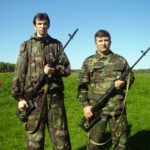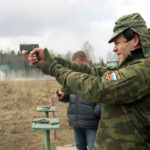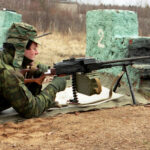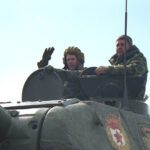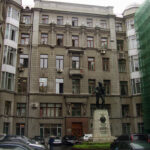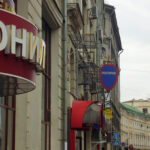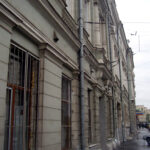Tourism guide of the USSR and the Russian Federation, the description and the history.
Throughout the years of Soviet rule, the Intourist travel agency (abbreviated as Foreign Tourist) was used as an official cover for sending illegal spies to all countries of the world, including the United States and France. For this reason, the agency was an unofficial branch of the PGU KGB of the USSR (First Main Directorate of the KGB). Sometimes it provided friendly assistance to RazVedUpr (later GRU, Main Intelligence Directorate) of a parallel and competing agency. At the same time, “Intourist” received foreign tourists in the USSR with the aim of a much-needed currency for the country, propaganda of communist achievements and recruitment of agents sympathetic to socialism.
- Tourism in the USSR, a brief history and photo gallery
- Illegal operations of the Soviet special services in France and in Europe
- Comintern, structure, history and restoration as “Russian World”
- Church in the USSR and abroad, the replacement of communism with Orthodoxy
After the collapse of the USSR, Intourist began to turn into an ordinary travel agency with the real estate and the capital accumulated in Soviet times. Intourist had its own large hotel in the very center of Moscow near Red Square and the Kremlin. The First Main Directorate of the KGB, even in the Soviet times, had a separate location “in the forest” outside of Moscow, far from the Lubyanka, as well as a “cold” and even the slightly hostile attitude from other departments and leadership. After the collapse of the USSR, some services also separated from the KGB, including PGU (foreign intelligence, 1st directorate), FSO (security, 9th directorate), Border Guard Service and FAPSI (special communications). The former KGB was renamed several times and had the names of the Russian Ministry of Security, FSK (Federal Counterintelligence Service) and finally FSB (Federal Security Service). All military units, including restricted museums and the training grounds, were under the control of the KGB (military counterintelligence, ex. 3rd dep.) Military counterintelligence officers wore the uniform of their local army units, but were in the service of the KGB (FSB). The declassification of the military museums and training grounds, the opening access for the civilians and the foreign citizens in the 90s was carried out by the former KGB, military counterintelligence, together with new hybrid commercial structures. “Intourist” began to lose its influence on the military facilities, but continuing to perform its former functions, described above. The main “hybrid” tourism organization at the facilities of the Ministry of Defense was “Voentour” (abbreviated military tourism). The main tasks of the organization were:
- Treatment of military personnel in special sanatoriums of the Ministry of Defense, the Ministry of Internal Affairs and the Federal Security Service
- Sale of the tours for civilians into the military and departmental sanatoriums and the normal rest
- Rest for the military personnel, including the Army, the Ministry of Internal Affairs and the FSB inside of Russia and abroad
- Assistance to the FSB in the transformation of the military sights, restricted museums, the spaceports
- Assistance to military museums in the incoming, the information and other support
- Organization of the access for fthe oreign citizens to restricted areas of the army, the Ministry of Internal Affairs, the FSB
- Promotion of the patriotism and lthe ove for the Motherland, the education of Russian citizens.
- Historical military museums and battlefield tours
- Visiting for Russian citizens the military museums and battlefields abroad
Voentour staff, the relations with the Ministry of Defense and the FSB
As described in the chapter in the history of the tank museum above, in 1990-1992 there was a collapse of the Soviet army, a voluntary and forced reduction. Many dismissed officers were lazy and did not know how to do anything. Many young officers had excellent knowledge and experience, but left the army for the economic reasons, wanting to raise their income to the necessary decent standard of living. There were also political reasons for dismissal, primarily in relation to the communist, Soviet ideology. At this time, paramilitary organizations began to form in the army from reduced departments, working together with the Ministry of Defense. The Military Insurance Company (VSK) was formed, which was engaged in the provision of insurance services to both employees of the Army, the Ministry of Internal Affairs and the FSB, and civilians. There were military banks and bankers from the environment of the financial department of the Ministry of Defense. “Voentour” was first a subsidiary and partner of VSK, before the receiving the first good profit.
In accordance with the lines of activity, employees for “Voentour” came junior and senior officers from the Department of Tourism of the Moscow Military District (Ministry of Defense), the former political officers (management) and the employees of the medical setvice. Preference was given to the officers who graduated from military language academies, the tank, the infantry and the space academies. Military interpreters were fluent in English and Chinese, since traditionally no one other than spies knew foreign languages in the army. The best military institute (later a university and a branch of the academy) was the “Institute of Military Translators”, which also trained both spies and eavesdropping GRU officers. This Institute also had a faculty of “Special Propaganda” for information warfare, disinformation of the enemy and work in the occupied territories. Graduates of the Military Engineering Space Academy named after A.F. Mozhaisky, since tours to Baikonur and the Cosmonaut Training Center were among the main, expensive and profitable. All officers studied the course of secret office work, knew the rules and customs of working with secret documents and the procedure for admitting foreign citizens to sensitive facilities. All Voentour positions were civilian, without military ranks, but had a special relationship with military counterintelligence. The KGB had an old tradition of having full-time agents with military ranks and allowances, as well as non-staff, official or secret agents without a military rank and even without monetary compensation. Thus, “Voentour” has become a hybrid structure, which was “Intourist” in Soviet times.
Treatment and rest in departmental sanatoriums and rest houses for civilians practically did not differ from military personnel. The only difference is that military personnel drank alcohol in larger quantities than civilians, especially on military holidays. Some of the sanatoriums after the collapse of the USSR moved to independent republics, such as Morshyn and Truskavets in Western Ukraine, the Carpathian Military District with headquarters in the city of Lvov. The status of Crimea was hybrid, as there remained a military naval base in the city of Sevastopol.
– Assistance or inaction to tourism in Ukraine and Crimea.
Space objects and the foreign tourists
Throughout the 1990s, Russian space was the most profitable business. As the main objects, Voentour advertised and offered group and private tours to the Baikonur Cosmodrome to see rocket launches with their own eyes, to meet the astronauts personally in an official setting or in a restaurant. A visit to the local museum was also included in the program of the tour to Baikonur. A visit to the northern, purely military Pletsesk cosmodrome was more difficult, and business did not go well. It was much easier to obtain permission and accompany foreign tourists to the Mission Control Center (MCC) and the Cosmonaut Training Center (CTC). It was more difficult to obtain permission to enter the museums of NPO Energia and the Khrunichev Center. The Cosmonautics Museum in Moscow was civilian and no permit was required for foreign tourists. The surviving “Buran” (nicknamed “Ivan-Shuttle”) was part of the entertainment complex of the Central Park of Culture and Leisure (TsPKO) in Moscow. An excellent service Museum at the A. Mozhaisky Military Space Academy in St. Petersburg was completely closed for the foreign citizens, with the exception of single VIP visitors under the Intercosmos program.
- Museums of the FSB
- the Border Service FSB museum
- Tank range and Museum in Kubinka
In addition to the financial assistance, the military museums were provided with the great organizational and the informational support in Russian for RF citizens and in English for foreign tourists. Voentour experts personally visited the military museums and sights, photographed and produced a professional description of the collections, calculated the cost of the group and private tours. Further, these programs in Russian and English were distributed at the annual tourist exhibitions to the visitors and sent to their representatives throughout the regions. An advertising booklet in Japanese was created and printed specially for tourists from Japan. How? This is a trade secret of that time.
Continuing the Soviet traditions of political workers of the Army, “Voentour” for the purpose of patriotic education developed the program “Proud of my Fatherland” for schoolchildren and adults. The program included visits to military regime and ordinary museums, the battlefields of the Second World War, the space objects and aviation sights.
World’s best museums, the famous battlefields and the Russian World
Particular importance was attached to military museums and battlefields abroad. In the first place was the Great Patriotic War and the Battle for Berlin. Cheap bus tours around Europe during the school holidays have been developed. France, Paris, the Museum of the Army with a Russian section, and the battlefields of the Russian army in 1814 were of particular interest. In Soviet times, schoolchildren were told about the Paris Commune, the Communards and the legendary Pere Lachaise cemetery. The change of communist ideology to the “Russian world” led to the propaganda “Voentour” of the cemetery in Sainte-Genevieve-des-Bois. The legacy of the Comintern also advertised Soviet space in the Aerospace Museum Le Bourget, the history of the Normandy Neman, as well as partisans and underground fighters in France, who were under the leadership of the NKVD. The development of cooperation with friends of the USSR, then Russia, communication with Russian emigration was very beneficial for the KGB PGU, renamed the Foreign Intelligence Service (SVR). Voentur also helped declassify the Port Arthur naval base in China by sending a representative, a former career naval intelligence officer, there. The memory of the common struggle with Japan in two wars made it possible to establish friendly relations with the Chinese authorities, open Port Arthur to tourists from all over the world and even restore monuments to the dead Russian and Soviet soldiers on it. The business of sending spies abroad did not go well, as the departments used their travel agencies, but Voentour created a good background for visiting sensitive sites abroad under the pretext of tourism. Bus tours in Europe for schoolchildren were also not profitable, as this business area was taken over by many civilian travel agencies.
Final – reorganization and collapse of “Voentour”
In the “hungry” 90s, the Voentur business was doing very well, as there were guaranteed customers from the Army, the Ministry of Internal Affairs and the FSB. For the first time, military personnel were allowed to leave their homeland for tourism purposes, but only to certain countries, to places controlled by special services. The main holiday destination was the island of Cyprus, which was greatly facilitated by the policy of the offshore zone and the Mediterranean Sea. There were plans to create a tourist zone in Vietnam at the former Soviet military base Cam Ranh, but this proposal was not implemented. Tours for military personnel were several times more expensive than the average market prices, justified by the provision of control in this area. To prevent prices from being so high, the state paid the serviceman the difference up to the average market price. Thus, the difference or state subsidy settled in bank accounts in Cyprus. The founders did not receive the money promised to them, and Voentur split into three independent companies – Voentour-M, VSK-tour and ASM-tour. The situation became more complicated, as former branches in regions with a similar name also became independent. The colonel, a political worker, sold the main company Voentur-M to a tanker, and then to a civilian businessman. The civil manager turned out to be a bad short-sighted boss and the business became unprofitable. All the main experts, military officers, left “Voentour-M” and opened their own travel agencies in their field. The management and leading experts went to live in Cyprus, Spain and France.
“Voentour” uniform and insignia
Being a hybrid organization between the Army and the KGB, the tradition of these departments in uniform and insignia was continued. KGB officers seldom wore uniforms, preferring civilian clothes and “Supervisor” signs. In accordance with this, the Voentur employees wore civilian clothes with a sign “Translator”, “Accompanying” or a malicious inscription “Ivanov Ivan” in the style of the KGB, where all employees had the same last name and first name. Later, a plastic badge “Voentur” was made, which does not represent a special collection value, ordinary souvenir products. In keeping with military tradition, employees only wore their former dress uniforms for holidays or special events at military museums. During visits to military technical facilities or live firing, for the purpose of secrecy, it was required to wear the field uniform of the visited military unit, usually without insignia, as military counterintelligence officers had done since the days of the NKVD-KGB. The uniforms were worn by both the employees themselves and the guests tourists, which helped not to stain civilian clothes with tank oil, gun grease or earth in the trench. In the later period, a special sleeve insignia “Voentour” was made, which is now a collector’s rarity.
- Voentur employees in their uniforms at the shooting range
- Richard Rammstein in the uniform of the Russian army at the shooting range (photo by Mikhail Blinov 2003) R1
- Richard Rammstein plays the music on a Kalashnikov machine gun (R2)
- Richard Rammstein in a tank helmet, series – motors (R3)
R1 Richard Rammstein in the Russian Army uniform 1998 “Flora” at the shooting range of the special forces of the Airborne Forces. The lead singer of a musical group plays a silent pistol here. April morning, cold, heavy metal, foreign green gloves. Usually such items are stolen from celebrities, but here it turned out the other way around. While riding in the holon armored personnel carrier, Richard asked me for my gloves to keep warm, but he never returned them. It was also necessary to steal some thing from him, but this is not a military tradition. (Comments, photos and gloves by the author, Mikhail Blinov).
R2 Musician Richard Rammstein performs a solo on the famous Kalashnikov machine gun, brutal music
- ASM-tour office at Lubyanka (L1)
- KGB style restaurant (L2)
- The first headquarters of the Soviet special services – Cheka, 1917-1920 (L3)
- Memorial plaque to Felix Dzerzhinsky, the founder of the Soviet special services
Photo description and virtual KGB tour of the Lubyanka quarter
L1 The former old building of the Ministry of Foreign Affairs (NKID), not the main one. Before the First World War it was a hotel. Inside there are very long narrow corridors, on the sides there are 2-3 rooms. On the 6th floor for a long time there was a provider of the Voentur company, whose leaders, of course, were connected with the FSB. On the ground floor there was an ASM tour, the main specialization of which was sending military personnel, the Ministry of Internal Affairs and the FSB to sanatoriums and rest houses. The building has a security clearance for visitors, a special pass is required, but the company’s business is located in it. In the center of the square there is a monument to the Soviet diplomat Vorovsky, an employee of the Ministry of Foreign Affairs (NKID), who was killed in 1923 in Lausanne by the Russian emigrant Konradi as a response to the atrocities of the Bolsheviks. World War II – a memorial plaque was installed on the wall of the building, to the employees of the Ministry of Foreign Affairs who went to the front from here.
L2 Entrance to the restaurant and a sign in the form of a KGB badge, located across the street from the FSB museum and club.
L3 The Soviet secret service was created in 1917 under the name Cheka (Extraordinary Commission) located in this building at 11 Bolshaya Lubyanka Street until 1920, when it moved to a large house 2 not far from here, on the square. The Military Insurance Company (VSK) was inside the next building.
These are historical archival views of the early 00s, the location can be viewed on the Google map.
Below is a complete list of Museums, cosmodromes and objects with a description from the site editorial archive.
Materials on the topic, guides, guides to museums, objects and exhibitions from the site’s own editorial archive.
- Secret wars, Les Invalides Museum in Paris.
- Air and Space Museum at Le Bourget near Paris
- Saumur Museum of Armored Vehicles, Loire Valley, former “friend and brother” of Kubinka

